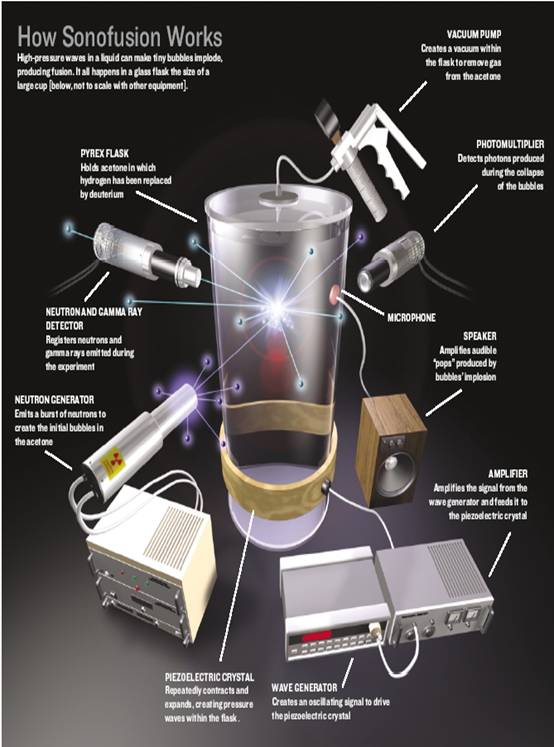Bubble Power
Published on Nov 23, 2015
Abstract
In sonofusion a piezoelectric crystal attached to liquid filled Pyrex flask send pressure waves through the fluid, exciting the motion of tiny gas bubbles. The bubbles periodically grow and collapse, producing visible flashes of light.
The researchers studying these light emitting bubbles speculated that their interiors might reach such high temperature and pressure they could trigger fusion reaction. Tiny bubbles imploded by sound waves can make hydrogen nuclei fuse- and may one day become a revolutionary new energy source.
When a gas bubble in a liquid is excited by ultrasonic acoustic waves it can emit short flashes of light suggestive of extreme temperatures inside the bubble. These flashes of light known as sonoluminescence, occur as the bubble implode or cavitates. It is show that chemical reactions occur during cavitations of a single, isolated bubble and yield of photons, radicals and ions formed. That is gas bubbles in a liquid can convert sound energy in to light.
Sonoluminescence also called single-bubble sonoluminescence involves a single gas bubble that is trapped inside the flask by a pressure field. For this loud speakers are used to create pressure waves and for bubbles naturally occurring gas bubbles are used. These bubbles can not withstand the excitation pressures higher than about 170 kilopascals. Pressures higher than about 170 kilopascals would always dislodge the bubble from its stable position and disperse it in the liquid. A pressure at least ten times that pressure level to implode the bubbles is necessary to trigger thermonuclear fusion. The idea of sonofusion overcomes these limitations.
Introduction of Bubble Power
Sonofusion is technically known as acoustic inertial confinement fusion. In this we have a bubble cluster (rather than a single bubble) is significant since when the bubble cluster implodes the pressure within the bubble cluster may be greatly intensified. The centre of the gas bubble cluster shows a typical pressure distribution during the bubble cluster implosion process. It can be seen that, due to converging shock waves within the bubble cluster, there can be significant pressure intensification in the interior of the bubble cluster.
This large local liquid pressure (P>1000 bar) will strongly compress the interior bubbles with in the cluster, leading to conditions suitable for thermonuclear fusion. More over during the expansion phase of the bubble cluster dynamics, coalescence of some of interior bubbles is expected, and this will lead to the implosion of fairly large interior bubbles which produce more energetic implosions.

The apparatus consists of a cylindrical Pyrex glass flask 100 m.m. in high and 65m.m.in diameter. A lead-zirconate-titanate ceramic piezoelectric crystal in the form of a ring is attached to the flask's outer surface. The piezoelectric ring works like the loud speakers in a sonoluminescence experiment, although it creates much stronger pressure waves. When a positive voltage is applied to the piezoelectric ring, it contracts; when the voltage is removed, it expands to its original size.
The flask is then filled with commercially available deuterated acetone (C 3 D 6 O), in which 99.9 percent of the hydrogen atoms in the acetone molecules are deuterium (this isotope of hydrogen has one proton and one neutron in its nucleus). The main reason to choose deuterated acetone is that atoms of deuterium can undergo fusion much more easily than ordinary hydrogen atoms. Also the deuterated fluid can withstand significant tension (stretching) without forming unwanted bubbles. The substance is also relatively cheap, easy to work with, and not particularly hazardous.
Applications :
• Thermonuclear fusion gives a new, safe, environmental friendly way to produce electrical energy.
• This technology also could result in a new class of low cost, compact detectors for security applications. That use neutrons to probe the contents of suitcases.
• Devices for research that use neutrons to analyze the molecular structure of materials.
• Machines that cheaply manufacture new synthetic materials and efficiently produce tritium, which is used for numerous applications ranging from medical imaging to watch dials.
A new technique to study various phenomenons in cosmology, including the working of neutron star and black holes.
With the steady growth of world population and with economic progress in developing countries, average electricity consumption per person has increased significantly.
There fore seeking new sources of energy isn't just important, it is necessary. So for more than half a century, thermonuclear fusion has held out the promise of cheap clean and virtually limitless energy. Unleashed through a fusion reactor of some sort, the energy from 1 gram of deuterium, an isotope of hydrogen, would be equivalent to that produced by burning 7000 liters of gasoline. Deuterium is abundant in ocean water, and one cubic kilometer of seawater could, in principle, supply all the world's energy needs for several hundred years.
More Seminar Topics:
Embedded Web Technology, Embedded System in Automobiles, Electrooculography, Electronic Toll Collection, Electronic Counter-Countermeasures, Electro Dynamic Tether, Easy-To-Swallow Wireless Telemetry, Earthing Transformers For Power Systems, Distributed COM, Direct Current Machines, DD Using Bio-robotics, Data Loggers, Concentrating Collectors, Clos Architecture in OPS, Chip MorphingRelated Seminar Topics
- Lunar Reconnaissance Orbiter Miniature RF Technology Demonstration
- Secure Electronic Voting System Based on Image Steganography
- Securing Underwater Wireless Communication Networks
- Security In Embedded Systems
- Third Generation Solid State Drives
- Face Recognition Using Neural Network